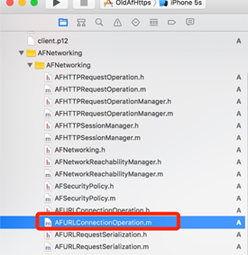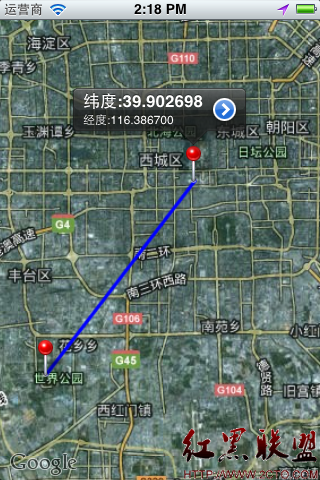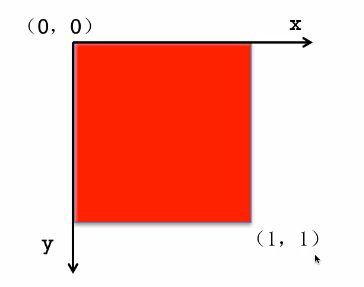詳解iOS開發 - 用AFNetworking實現https單向驗證,雙向驗證
自蘋果宣布2017年1月1日開始強制使用https以來,htpps慢慢成為大家討論的對象之一,不是說此前https沒有出現,只是這一決策讓得開發者始料未及,博主在15年的時候就做過https的接口,深知此坑之深,原因就是自身對這方面知識不了解加上網上的資料少,除此外還有博客不知對錯就互相轉載,導致當時網上幾乎找不到能用的代碼,這一點,博主說的毫不誇張。
鑒於此,博主一直想填一下這個坑,多增加一些正確的代碼,來供廣大開發者使用,後來一直被擱置,經過嘗試後,博主現將整理好的代碼發布在這裡,希望能幫到焦急尋找的開發者。
1.先來說說老的AFNetworking2.x怎麼來實現的
博主在網上看過幾篇帖子,其中說的一些方法是正確的,但是卻並不全對,由於那幾篇博客幾乎一樣,博主不能確定最早的那篇是誰寫的,所以就重新在下面說明下方法:
1)倒入client.p12證書;
2)在plist文件做如圖配置:

3)在AFNetworking中修改一個類:

找到這個文件,在裡面增加一個方法:
- (OSStatus)extractIdentity:(CFDataRef)inP12Data toIdentity:(SecIdentityRef*)identity {
OSStatus securityError = errSecSuccess;
CFStringRef password = CFSTR("證書密碼");
const void *keys[] = { kSecImportExportPassphrase };
const void *values[] = { password };
CFDictionaryRef options = CFDictionaryCreate(NULL, keys, values, 1, NULL, NULL);
CFArrayRef items = CFArrayCreate(NULL, 0, 0, NULL);
securityError = SecPKCS12Import(inP12Data, options, &items);
if (securityError == 0)
{
CFDictionaryRef ident = CFArrayGetValueAtIndex(items,0);
const void *tempIdentity = NULL;
tempIdentity = CFDictionaryGetValue(ident, kSecImportItemIdentity);
*identity = (SecIdentityRef)tempIdentity;
}
if (options) {
CFRelease(options);
}
return securityError;
}
再修改一個方法:
用下面的這段代碼替換NSURLConnectionDelegate中的同名代碼,
- (void)connection:(NSURLConnection *)connection
willSendRequestForAuthenticationChallenge:(NSURLAuthenticationChallenge *)challenge
{
NSString *thePath = [[NSBundle mainBundle] pathForResource:@"client" ofType:@"p12"];
//倒入證書 NSLog(@"thePath===========%@",thePath);
NSData *PKCS12Data = [[NSData alloc] initWithContentsOfFile:thePath];
CFDataRef inPKCS12Data = (__bridge CFDataRef)PKCS12Data;
SecIdentityRef identity = NULL;
// extract the ideneity from the certificate
[self extractIdentity :inPKCS12Data toIdentity:&identity];
SecCertificateRef certificate = NULL;
SecIdentityCopyCertificate (identity, &certificate);
const void *certs[] = {certificate};
// CFArrayRef certArray = CFArrayCreate(kCFAllocatorDefault, certs, 1, NULL);
// create a credential from the certificate and ideneity, then reply to the challenge with the credential
//NSLog(@"identity=========%@",identity);
NSURLCredential *credential = [NSURLCredential credentialWithIdentity:identity certificates:nil persistence:NSURLCredentialPersistencePermanent];
// credential = [NSURLCredential credentialWithIdentity:identity certificates:(__bridge NSArray*)certArray persistence:NSURLCredentialPersistencePermanent];
[challenge.sender useCredential:credential forAuthenticationChallenge:challenge];
}
4)發起請求
NSString *url = @"xxxxxxxxxx";
// 1.獲得請求管理者
AFHTTPRequestOperationManager *mgr = [AFHTTPRequestOperationManager manager];
//2設置https 請求
AFSecurityPolicy *securityPolicy = [AFSecurityPolicy policyWithPinningMode:AFSSLPinningModeCertificate];
securityPolicy.allowInvalidCertificates = YES;
mgr.securityPolicy = securityPolicy;
// 3.發送POST請求
[mgr POST:url parameters:nil success:^(AFHTTPRequestOperation * _Nonnull operation, id _Nonnull responseObject) {
NSLog(@"responseObject: %@", responseObject);
} failure:^(AFHTTPRequestOperation * _Nonnull operation, NSError * _Nonnull error) {
NSLog(@"Error: %@", error);
}];
到此,老版的AFNetworking請求https接口的雙向驗證就做完了,但是有一個問題,這裡需要改動AFNetworking的代碼,何況新的AFNetworking已經有了,為了保持代碼的活力,老的應該摒棄的,而且更新pods後肯定替換的代碼就沒了,也是一個問題,不要急,下面來說說怎麼用新的AFNetworking,並解決被pods更新替換代碼的問題。
最後再說一點,使用老的AF來請求,只用到了client.p12文件,並沒有用到server.cer,在新的裡面是有用到的,猜測可能是客戶端選擇信任任何證書導致的,就變成了單向的驗證。
Demo放在最後
2.來說說新的AFNetworking3.x怎麼來實現的
1)倒入client.p12和server.cer文件
2)plist內的設置,這是和上面一樣的:

3)這裡可不需要修改類裡面的代碼,但是這裡需要重寫一個方法:
NSString *url = @"https://test.niuniuhaoguanjia.com/3.0.0/?service=City.GetCityList";
NSString *certFilePath = [[NSBundle mainBundle] pathForResource:@"server" ofType:@"cer"];
NSData *certData = [NSData dataWithContentsOfFile:certFilePath];
NSSet *certSet = [NSSet setWithObject:certData];
AFSecurityPolicy *policy = [AFSecurityPolicy policyWithPinningMode:AFSSLPinningModeCertificate withPinnedCertificates:certSet];
policy.allowInvalidCertificates = YES;
policy.validatesDomainName = NO;
_manager = [AFHTTPSessionManager manager];
_manager.securityPolicy = policy;
_manager.requestSerializer = [AFHTTPRequestSerializer serializer];
_manager.responseSerializer = [AFHTTPResponseSerializer serializer];
_manager.responseSerializer.acceptableContentTypes = [NSSet setWithObjects:@"application/json", @"text/json", @"text/javascript",@"text/plain", nil];
//關閉緩存避免干擾測試r
_manager.requestSerializer.cachePolicy = NSURLRequestReloadIgnoringLocalCacheData;
[_manager setSessionDidBecomeInvalidBlock:^(NSURLSession * _Nonnull session, NSError * _Nonnull error) {
NSLog(@"setSessionDidBecomeInvalidBlock");
}];
//客戶端請求驗證 重寫 setSessionDidReceiveAuthenticationChallengeBlock 方法
__weak typeof(self)weakSelf = self;
[_manager setSessionDidReceiveAuthenticationChallengeBlock:^NSURLSessionAuthChallengeDisposition(NSURLSession*session, NSURLAuthenticationChallenge *challenge, NSURLCredential *__autoreleasing*_credential) {
NSURLSessionAuthChallengeDisposition disposition = NSURLSessionAuthChallengePerformDefaultHandling;
__autoreleasing NSURLCredential *credential =nil;
if([challenge.protectionSpace.authenticationMethod isEqualToString:NSURLAuthenticationMethodServerTrust]) {
if([weakSelf.manager.securityPolicy evaluateServerTrust:challenge.protectionSpace.serverTrust forDomain:challenge.protectionSpace.host]) {
credential = [NSURLCredential credentialForTrust:challenge.protectionSpace.serverTrust];
if(credential) {
disposition =NSURLSessionAuthChallengeUseCredential;
} else {
disposition =NSURLSessionAuthChallengePerformDefaultHandling;
}
} else {
disposition = NSURLSessionAuthChallengeCancelAuthenticationChallenge;
}
} else {
// client authentication
SecIdentityRef identity = NULL;
SecTrustRef trust = NULL;
NSString *p12 = [[NSBundle mainBundle] pathForResource:@"client"ofType:@"p12"];
NSFileManager *fileManager =[NSFileManager defaultManager];
if(![fileManager fileExistsAtPath:p12])
{
NSLog(@"client.p12:not exist");
}
else
{
NSData *PKCS12Data = [NSData dataWithContentsOfFile:p12];
if ([[weakSelf class]extractIdentity:&identity andTrust:&trust fromPKCS12Data:PKCS12Data])
{
SecCertificateRef certificate = NULL;
SecIdentityCopyCertificate(identity, &certificate);
const void*certs[] = {certificate};
CFArrayRef certArray =CFArrayCreate(kCFAllocatorDefault, certs,1,NULL);
credential =[NSURLCredential credentialWithIdentity:identity certificates:(__bridge NSArray*)certArray persistence:NSURLCredentialPersistencePermanent];
disposition =NSURLSessionAuthChallengeUseCredential;
}
}
}
*_credential = credential;
return disposition;
}];
4)發起請求
//第三步和這一步代碼是放在一起的,請注意哦
[_manager GET:url parameters:nil progress:^(NSProgress * _Nonnull downloadProgress) {
} success:^(NSURLSessionDataTask * _Nonnull task, id _Nullable responseObject) {
NSDictionary *dic = [NSJSONSerialization JSONObjectWithData:responseObject options:NSJSONReadingMutableContainers error:nil];
NSLog(@"JSON: %@", dic);
} failure:^(NSURLSessionDataTask * _Nullable task, NSError * _Nonnull error) {
NSLog(@"Error: %@", error);
NSData *data = [error.userInfo objectForKey:@"com.alamofire.serialization.response.error.data"];
NSString *str = [[NSString alloc]initWithData:data encoding:NSUTF8StringEncoding];
NSLog(@"%@",str);
}];
另外還要加上一個方法:
+(BOOL)extractIdentity:(SecIdentityRef*)outIdentity andTrust:(SecTrustRef *)outTrust fromPKCS12Data:(NSData *)inPKCS12Data {
OSStatus securityError = errSecSuccess;
//client certificate password
NSDictionary*optionsDictionary = [NSDictionary dictionaryWithObject:@"證書密碼"
forKey:(__bridge id)kSecImportExportPassphrase];
CFArrayRef items = CFArrayCreate(NULL, 0, 0, NULL);
securityError = SecPKCS12Import((__bridge CFDataRef)inPKCS12Data,(__bridge CFDictionaryRef)optionsDictionary,&items);
if(securityError == 0) {
CFDictionaryRef myIdentityAndTrust =CFArrayGetValueAtIndex(items,0);
const void*tempIdentity =NULL;
tempIdentity= CFDictionaryGetValue (myIdentityAndTrust,kSecImportItemIdentity);
*outIdentity = (SecIdentityRef)tempIdentity;
const void*tempTrust =NULL;
tempTrust = CFDictionaryGetValue(myIdentityAndTrust,kSecImportItemTrust);
*outTrust = (SecTrustRef)tempTrust;
} else {
NSLog(@"Failedwith error code %d",(int)securityError);
return NO;
}
return YES;
}
沒錯,我們是要封裝一下,可是要怎麼封裝呢?博主嘗試了集中都失敗了,真是百思不得解,相信主動去封裝的開發者也會碰到封裝後請求失敗的問題,也許你成功了,但是這裡需要注意一個在block內使用變量的問題,具體的可以去看博主怎麼封裝的。
到這裡,新的AF請求https就已經結束了,想看封裝的,Demo放在最後。
3.單向驗證
說到這個,不得不說一下網上的很多方法,都把單向驗證當作雙向的,其實也是並不理解其原理,關於原理,請看這裡
代碼實現AF都是一樣的:
//AF加上這句和下面的方法
_manager.securityPolicy = [self customSecurityPolicy];
/**** SSL Pinning ****/
- (AFSecurityPolicy*)customSecurityPolicy {
NSString *cerPath = [[NSBundle mainBundle] pathForResource:@"server" ofType:@"cer"];
NSData *certData = [NSData dataWithContentsOfFile:cerPath];
AFSecurityPolicy *securityPolicy = [AFSecurityPolicy policyWithPinningMode:AFSSLPinningModeCertificate];
[securityPolicy setAllowInvalidCertificates:YES];
NSSet *set = [NSSet setWithObjects:certData, nil];
[securityPolicy setPinnedCertificates:@[certData]];
/**** SSL Pinning ****/
return securityPolicy;
}
4.Demo下載福利
因為證書安全問題,Demo 裡的證書博主刪除了,請見諒,請大家放入自己的證書。
老的AF訪問httpsDemo
新的AF訪問httpsDemo
以上就是本文的全部內容,希望對大家的學習有所幫助,也希望大家多多支持本站。




